Out of possession, the 4-4-2 is perhaps the most common shape used in football. Diego Simeone is the coach who managed to implement this in the best and more efficient way. This is mainly due to the fact that is the easiest way to evenly cover more spaces having close distances and distinct lines. Beside the shape, the player’s movements, roles and responsibilities on the pitch are also important. It is the coach’s philosophy and the reflection of his methodology that will give life to the way of play.
Table of Contents
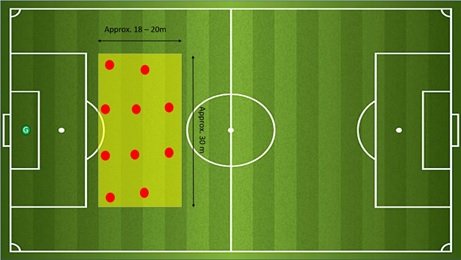
While teams and managers are always looking to find new approaches to defend with high, medium and low block, many teams in professional football are returning to the 4-4-2. Diego Simeone is using that almost from the beginning of his coaching career. The renaissance of the 4-4-2 has seen clubs such as Atletico Madrid, Manchester City and many other top sides rely on this shape out of possession, though each club has their own way of utilizing it. The defense in simple words means that a team has to control the space.
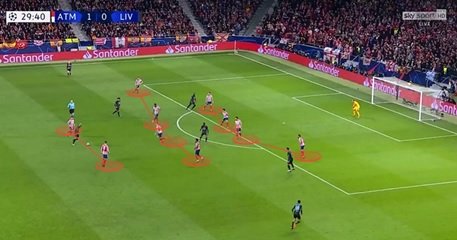
Basic guidelines used in a 4 – 4 – 2 low-block
Though all teams will have different principles and sub-principles which they will follow when out of possession, teams who defend in a 4-4-2 generally have similar guidelines to help steer their decision-making process and actions. If we start by looking to break down the key factors of a 4-4-2 low-block, many will agree that the following principles will hold true to most teams.
The main objective when defending is to prevent the opponents from scoring. The statistical aspect of the game shows that the majority of goals are coming from actions though central channels, inside the box or just outside the penalty area. So, the focus of a team defending in a low block is firstly to prevent the opponents to occupy these dangerous spaces and secondly if they do receive a pass in these areas, to not leave them unmark with time to make the attacking actions (shoot, pass, dribble etc.)
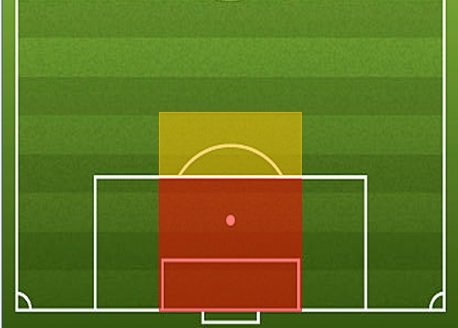
To achieve this, the players must have a clear idea on how to behave defensively in an organized way. The principles and sub-principles can offer a degree of specificity. This will help the players to better understand what they have to do in such situation. They will have a pre-settle plan and specific guidelines to follow. The primary objective when defending in a low block is to first prevent the opponent to enter the high scoring areas. Secondly is to recover the ball. This is a crucial point because when a player risks to recover the ball, there is a chance of committing a mistake that will allow the attacker to overcome him.
The main collective behavior to prevent the opposition from creating scoring opportunities :
- small distances between the lines and the players and
- the zonal pressing defense (ZPD).
By defending in a zonal and pressuring the ball all the time, it means that each player has it’s own area of responsibility. In that area the defender must pressure the on ball player when he enters in the specific area. The on-ball pressure is so important. The team in defense must always reduce the time and space that the on ball player has.
Example of how to structure the Principles and Sub – Principles in a Defensive Low Block Phase
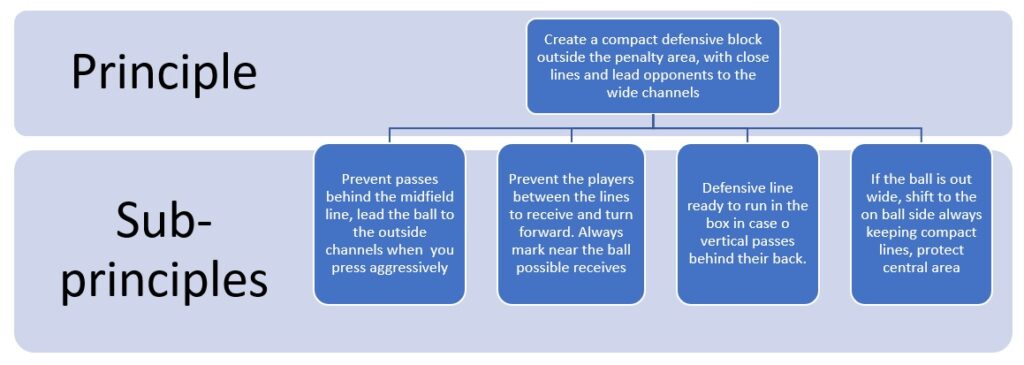
The main objective in the specific defensive phase is to create a compact bock, with shorts distances between the lines and the players. The distance between the defensive line and the forwards should be approx. 25 meters and between the players 8 – 10 meters. Of course, in the modern days, there are teams with very strong defensive approach in their games, and players very fit who can defend in a 18 – 20 meters block. An example is Simeone’s Atletico Madrid team.
The way to achieve that principle is through implementing and sub-principles. On the example below there are 4 sub principles.
- Sub -Principle 1: Prevent passes behind the midfield line, lead the ball to the wide channels when you can press aggressively.
The action is in the defending 1/3 so any pass behind the midfielders line’s , it means that probably it will be outside the penalty box which is a very dangerous space to concede a goal from shoot or from a vertical pass- assist. The defenders movements should block any passes to these spaces, showing them the wide channels where they can press aggressively and set pressing traps.
- Sub – Principle 2: Prevent the players located between the lines to receive passes and turn forward. Always mark the near the ball players.
The players located in between the lines can force a defending team to disorganized their positions. The defenders will be in a situation where they should think to jump to mark the player in front of them or to stay in their position as to avoid any movements behind them and in space.
- Sub – Principle 3: Defensive line ready to run in the box in case of vertical passes
A pass behind the defensive line means that the opponent’s are probably inside the penalty box which is the most dangerous space to concede a goal. Follow the opponent’s movement in the box. An alternative is to use of offside rule but it is risky.
- Sub – principle 4: if the ball is in a wide channel, shift to the on ball side in a compact block, protect the central area
The wide channels is the best place to risk to press aggressively. The outside line is an extra “defender” that can be used. Once the ball is out wide, prevent any switch of play or passes to interior spaces.
Key points
For any team that chooses to defend in a 4-4-2 low-block, there are some key points which should take into account to fully achieve the best possible outcome with the system. A well-structured 4-4-2 should be vertically compact and narrow. The shape and compactness of this formation should be prioritized above all else. This is to prevent any break ups within the shape, leaving dangerous spaces for the opponents to attack. This is especially critical when defending in the low block, because any gaps in the structure means the opposition will most likely find themselves with the ball inside the penalty area. Statistically, the majority of the goals comes form 1-touch shots inside the penalty box.
For any team that chooses to defend in a 4-4-2 low-block, there are some key points which should take into account to fully achieve the best possible outcome. The first priority should be to be vertically compact and narrow enough to prevent the progression of the ball and opponents between the lines in central channels. The shape and compactness of this system should be the number one priority. This is to prevent any break ups within the shape, leaving dangerous spaces for the opposition to attack. When defending so near to the goal, any gaps between the lines or the players might allow the opposition with clear chances to score.
Even though to keep the shape and compactness should be the top priority, if the opposition do manage to get the ball into a dangerous area, for example inside the penalty box, this should be sacrificed having in mind to protect the most perceived dangerous areas. With the opposition in possession and circulating the ball so close to the goal, the backline of the 4-4-2 should be positioned outside the box approximately one to two meters. This is to allow the defenders to be more aggressive in duels without having the risk to commit a penalty in a duel with an attacker. In our days with the use of VAR, the danger to commit a penalty is a factor that should be taken into account.
The importance of the distances
The players of the backline should have such distances as to be able to cover around 33 meters horizontally. The midfield line can be slightly more narrow to reduce the free space in the middle and protect the backline. This will help to prevent penetrations from central channels. From front to back, the 4-4-2 shape should cover around 15 – 18 meters vertically. Of course, when the team will move forward to a mid-block the distances will be greater. The importance to be compact vertically is to ensure that if the opponents manage to break one line, the next one will always be in a close range to offer defensive support for immediate pressure on the ball. This positioning on the pitch will allow the players to shift the block side to side and allow the players to take more risks to pressure the ball when is located in wide channels.
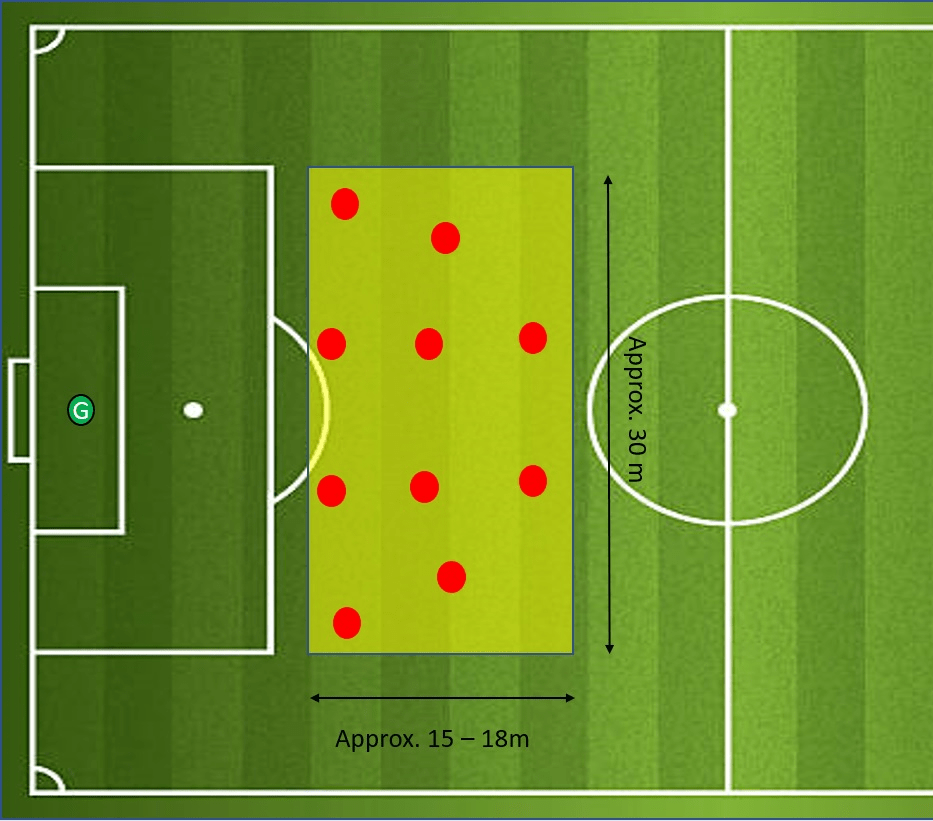
Even though the pressing on the ball is a key point when defending, many teams will allow the opposition to circulate possession without necessarily needing to engage. This is a more reactive defending behavior. Top teams like Barcelona, Manchester City, and Liverpool are using a different approach, a proactive behavior. These top teams likes to press high up the pitch and defend in a more proactive manner. They are always ready to take risks to recover the ball higher up the pitch. This will give them the chance to have the ball more times near the opposition’s goal.
Situations
Below we show in 3 different situations how the use of the 4 – 4 – 2 Low Block to defend. The aim is to get a general idea of what space is most important to protect. Also important is to know how to protect it, the player’s responsibilities, and how to react with the rest of the team’s organization.
Situation 1: Forcing the ball to outside channels and set pressing traps

In this scenario, the team in possession is attacking in a 4-3-3 with narrow wingers and high and wide fullbacks. The holding midfielder is in a deep position which allows the full backs to push up higher and the central defenders to have more wide positions. When the pass is played from the left central defender out to the left-back, the left-winger who is located in the left half-space has the intention to find the proper position to receive the ball between the lines.
Situation 2: Full backs push wide to defend
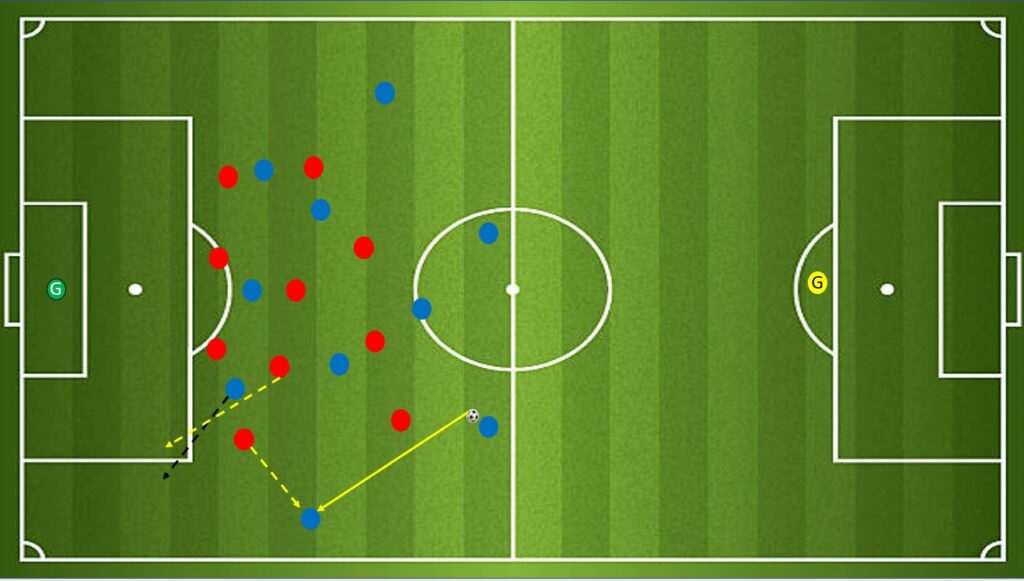
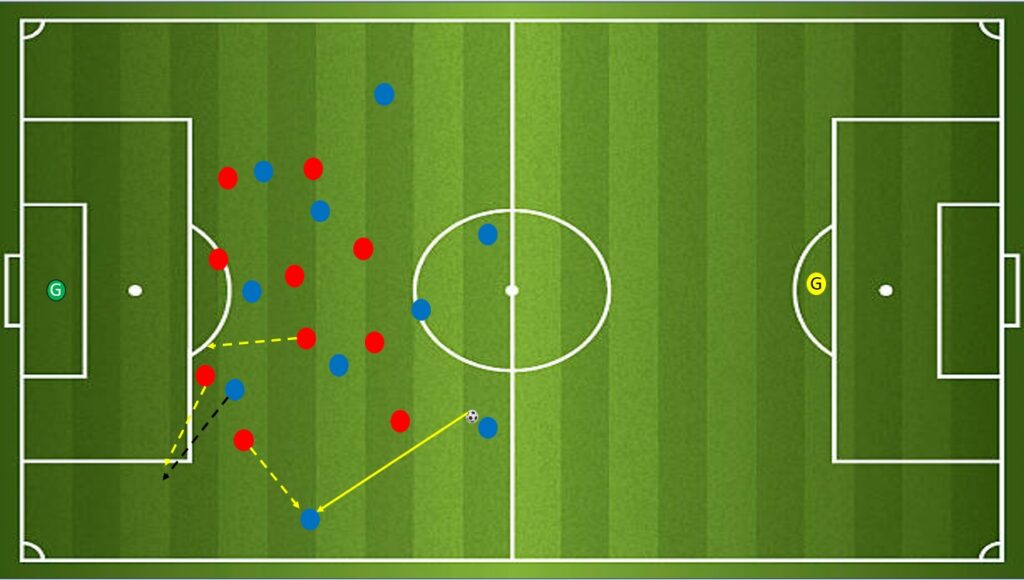
When the wide midfielders are in a high position and a pass is done outside wide, a fullback will most probably jump outside the low block to reduce the space of the wide attacker. This will create space behind his back for an attacker to run in space. This movement should be followed by a midfielder to allow the defending line to protect the central area inside the penalty box. In case the midfielder is not at a distance that can follow the movement, then an alternative should be for the central defender to move outside and one of the midfielders to take his position inside the box.
Situation 3: Switch of play

In the 3rd situation, the team has managed to shift to the right side and have a compact low block. The right midfielder has successfully pressed the on-ball forcing him to look for a long diagonal switch of play.
In a switch of play, the aim is to reduce the space from the wide receiver as soon. This is to avoid the easy 1 v 1 duel with much free space. The closest player quickly arrives at the full-back of the opposite side. By quickly rushing out while the ball is traveling, he will leave much space behind him. The near-side midfielder or winger (whoever is closest) should cover the space. This is to allow the center backs to keep a central position.
As we have already mentioned, the backline has a bit wider horizontal position than the midfield line. When the ball arrives on the opposite wing the left-back is closer to press as he was initially wider.
Conclusion
The 4-4-2 is a traditional formation used in the Defensive Phase, especially when using a defending medium or low block. Diego Simeone considered to be the prime example. It covers the largest areas of the pitch compared to other formations and offers compactness both vertically and laterally.
Though the shape can be effective against the majority of attacking formations, managers will always find new ways to create problems for the opposition defense. Against teams that overload their attacking front line can often be challenging for the defending team to find solutions. A coach should have other variation in mind also. Converting the formation to a 5 – 3 – 2 is easy with wide players following the movements of wide players up the pitch. With the availability of wingers being near the fullbacks.
The use of three defending lines can also create some problems with players playing in between the lines but this can be solved with defenders jumping in front and having a defensive coverage from the remaining players of the defending line. Of course, this needs much of communication and timing and it should be very well trained.
The use of this formation, a low block, in elite clubs as well as clubs closer to the bottom of the table goes to show its versatility as well as its strong foundation to build on.

